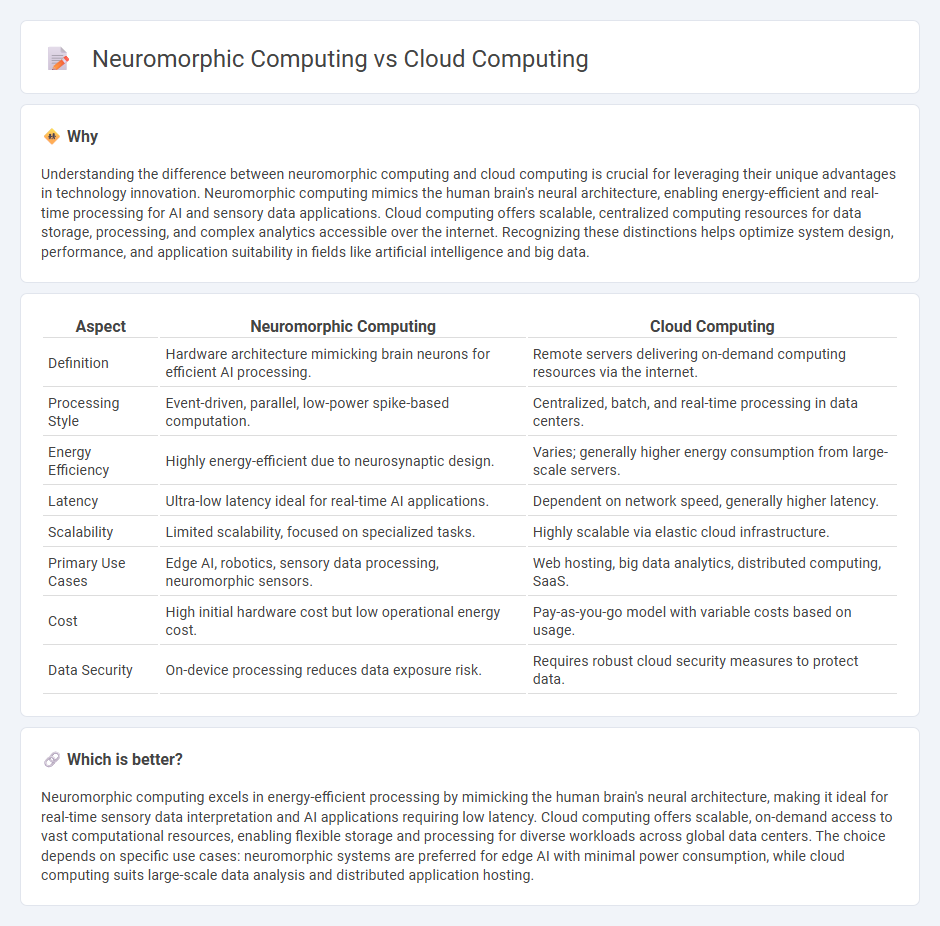
Neuromorphic computing leverages brain-inspired architectures to process information with high efficiency and low power consumption, contrasting with cloud computing's centralized data storage and large-scale processing over distributed servers. The distinct advantages of neuromorphic systems include real-time sensory processing and adaptive learning, while cloud computing excels in scalability and massive data handling. Discover how these technologies reshape the future of intelligent computing.
Why it is important
Understanding the difference between neuromorphic computing and cloud computing is crucial for leveraging their unique advantages in technology innovation. Neuromorphic computing mimics the human brain's neural architecture, enabling energy-efficient and real-time processing for AI and sensory data applications. Cloud computing offers scalable, centralized computing resources for data storage, processing, and complex analytics accessible over the internet. Recognizing these distinctions helps optimize system design, performance, and application suitability in fields like artificial intelligence and big data.
Comparison Table
| Aspect | Neuromorphic Computing | Cloud Computing |
|---|---|---|
| Definition | Hardware architecture mimicking brain neurons for efficient AI processing. | Remote servers delivering on-demand computing resources via the internet. |
| Processing Style | Event-driven, parallel, low-power spike-based computation. | Centralized, batch, and real-time processing in data centers. |
| Energy Efficiency | Highly energy-efficient due to neurosynaptic design. | Varies; generally higher energy consumption from large-scale servers. |
| Latency | Ultra-low latency ideal for real-time AI applications. | Dependent on network speed, generally higher latency. |
| Scalability | Limited scalability, focused on specialized tasks. | Highly scalable via elastic cloud infrastructure. |
| Primary Use Cases | Edge AI, robotics, sensory data processing, neuromorphic sensors. | Web hosting, big data analytics, distributed computing, SaaS. |
| Cost | High initial hardware cost but low operational energy cost. | Pay-as-you-go model with variable costs based on usage. |
| Data Security | On-device processing reduces data exposure risk. | Requires robust cloud security measures to protect data. |
Which is better?
Neuromorphic computing excels in energy-efficient processing by mimicking the human brain's neural architecture, making it ideal for real-time sensory data interpretation and AI applications requiring low latency. Cloud computing offers scalable, on-demand access to vast computational resources, enabling flexible storage and processing for diverse workloads across global data centers. The choice depends on specific use cases: neuromorphic systems are preferred for edge AI with minimal power consumption, while cloud computing suits large-scale data analysis and distributed application hosting.
Connection
Neuromorphic computing enhances cloud computing by enabling energy-efficient, brain-inspired processors that accelerate artificial intelligence workloads in data centers. This synergy allows cloud platforms to handle complex neural network algorithms with improved speed and reduced power consumption, optimizing resource allocation. Integrating neuromorphic chips into cloud infrastructure supports scalable, real-time data processing crucial for advanced machine learning applications and edge computing deployment.
Key Terms
Virtualization (Cloud Computing)
Virtualization in cloud computing enables the creation of multiple virtual machines on a single physical server, optimizing resource utilization and scalability for diverse applications. This technology decouples hardware from software, allowing dynamic allocation of computing power, storage, and networking resources to meet varying workload demands. Explore how virtualization revolutionizes cloud infrastructure by enhancing flexibility, cost-efficiency, and performance.
Synaptic Architecture (Neuromorphic Computing)
Synaptic architecture in neuromorphic computing mimics biological neural networks by using memristors or other nano-scale devices to replicate synapse functionality, enabling energy-efficient and adaptive information processing. Cloud computing relies on centralized data centers with traditional CPUs and GPUs, focusing on scalability and high-throughput for diverse workloads rather than brain-like synaptic connections. Explore the cutting-edge advancements in synaptic designs and their potential to revolutionize computing paradigms.
Scalability (Cloud Computing)
Cloud computing offers unparalleled scalability by dynamically allocating resources across distributed data centers to handle fluctuating workloads efficiently. This elastic scalability supports massive data processing and storage needs for businesses of all sizes, enabling rapid deployment and growth without significant upfront infrastructure costs. Explore how cloud computing's scalable architecture transforms digital operations and fuels innovation.
Source and External Links
What is Cloud Computing? Types, Examples and Benefits - Cloud computing is the on-demand delivery of hosted computing and IT services over the internet, allowing client devices to access rented computing resources like data, storage, and applications from remote data centers managed by service providers.
Cloud computing - Wikipedia - Cloud computing enables network access to a scalable, elastic pool of shareable physical or virtual resources with self-service provisioning, broad network access, resource pooling, rapid elasticity, and measured service, as defined by ISO and NIST standards.
What Is Cloud Computing? | IBM - Cloud computing provides on-demand access to computing resources--such as servers, storage, and applications--over the internet with pay-per-use pricing, offering flexibility and scalability without the need to own or manage physical hardware.
 dowidth.com
dowidth.com